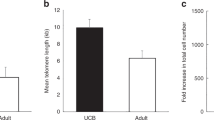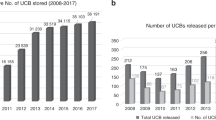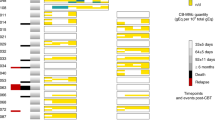Abstract
Cord blood (CB) stem and progenitor cells from related donors have been transplanted for past 20 years and from unrelated donors issued by public CB banks for 16 years. This brief look at public CB banking highlights aspects of its current status to suggest that accomplishing the currently required tasks, though no small undertaking, is not enough: much remains to be contributed. CB banking started in the 1930s, collecting blood for transfusion and showed that CB could be effectively collected, stored and administered intravenously without negative consequences. The realization that it contains hematopoietic ‘stem’ cells (actually, colony-forming units) followed discoveries elsewhere in hematopoiesis research, while HLA and unrelated BMT were being investigated. Progress in the exploration of ethnically stratified HLA allele frequencies, together with plausible neonatal (partial) immunological tolerance, seemed to predict initially frequent, unavoidable, but sufficiently tolerable HLA mismatching with CB grafts. Gluckman et al. and Boyse et al. proved that HLA-identical sibling CB grafts led to definitive engraftment. Technical developments in processing and freezing enabled public banks to accumulate large inventories and to supply grafts that could succeed despite major HLA incompatibility and low cell doses and provide hope for universal access to unrelated-donor transplantation. Public CB banking has thrived worldwide. Regulation and accreditation defined Good Tissue Practice in the CB banking environment and provided accepted do's, don't's and how to's. Startling advances continue to be made, not only technical, but including the description of molecular regulation in the function of natural killer and other cells involved in allogeneic recognition that will have dramatic effects and will permit further improvement in CB selection and use.
This is a preview of subscription content, access via your institution
Access options
Subscribe to this journal
Receive 12 print issues and online access
$259.00 per year
only $21.58 per issue
Buy this article
- Purchase on Springer Link
- Instant access to full article PDF
Prices may be subject to local taxes which are calculated during checkout
Similar content being viewed by others
References
Gluckman E, Broxmeyer HE, Auerbach AD, Friedman H, Douglas GW, DeVergie A et al. Hematopoietic reconstitution in a patient with Fanconi anemia by means of umbilical-cord blood from an HLA-identical sibling. N Engl J Med 1989; 321: 1174–1178.
Kurtzberg J, Laughlin M, Graham ML, Smith C, Olson JF, Halperin EC et al. Placental blood as a source of hematopoietic stem cells for transplantation into unrelated recipients. N Eng J Med 1996; 335: 157–166.
Laughlin ML, Eapen M, Rubinstein P, Wagner JE, Zhang MJ, Champlin RE et al. Outcomes after transplantation of cord blood or bone marrow from unrelated donors in adults with leukemia. N Engl J Med 2004; 351: 2265–2275.
Rubinstein P, Carrier CM, Scaradavou A, Kurtzberg J, Adamson J, Migliaccio AR et al. Outcomes among 562 recipients of placental-blood transplants from unrelated donors. New Engl J Med 1998; 339: 1565–1577.
Dobrila L, Coelho P, Rubinstein P . Transient Warming Events and Cell Viability of Placental/Umbilical Cord Blood (CBU), ISHAGE June 2001, Quebec, Canada.
Halbrecht J . Transfusion with placental blood. Lancet 1939; I: 202–204.
Rosenfield RE . Personal communication.
Ende M, Ende N . Hematopoietic transplantation by means of fetal (cord) blood: a new method. Va Med Mon 1972; 99: 276–280.
Knudtzon S . In vitro growth of granulocytic colonies from circulating cells in human cord blood. Blood 1974; 43: 357–361.
Prindull G, Prindull B, Meulen N . Haematopoietic stem cells (CFUc) in human cord blood. Acta Paediatr Scan 1978; 67: 413–416.
Fauser AA, Messner HA . Granuloerythropoietic colonies in human bone marrow, peripheral blood and cord blood. Blood 1978; 52: 1243–1248.
Nakahata T, Ogawa M . Hemopoietic colony-forming cells in umbilical cord blood with extensive capability to generate mono- and multipotential hemopoietic progenitors. J Clin Invest 1982; 80: 1324–1328.
Koike K . Cryopreservation of pluripotent and committed hemopoietic progenitor cells from human bone marrow and cord blood. Acta Paediatr Japan 1983; 25: 275–283.
Besalduch J . Naturaleza y características de los precursores Granulocitico-macrofágicos en Sangre de Cordón (doctoral thesis). Universitat de València: Valencia, Spain, 1985.
Broxmeyer HE, Douglas GW, Hangoc G, Cooper S, Bard J, English D et al. Human umbilical cord blood as a potential source of transplantable hematopoietic stem/progenitor cells. Proc Natl Acad Sci USA 1989; 86: 3828–3832.
Broxmeyer HE, Hangoc G, Cooper S, Ribeiro RC, Graves V, Yoder M et al. Growth characteristics and expansion of human umbilical cord blood and estimation of its potential for transplantation in adults. Proc Natl Acad Sci USA 1992; 89: 4109–4114.
Boyse EA, Broxmeyer HE, Douglas GW . Preservation of fetal and neonatal hematopoietic stem and progenitor cells of the blood. US patent 5004681 assigned to Biocyte corporation, 1991.
Wagner JE, Broxmeyer HE, Byrd RL, Zehnbauer B, Schmeckpeper B, Shah N et al. Transplantation of umbilical cord blood after myeloablative therapy: analysis of engraftment. Blood 1992; 79: 1874.
Vilmer E, Sterkers G, Rahimy C, Denamur E, Elion J, Broyart A et al. HLA-mismatched cord blood transplantation in a patient with advanced leukemia. Transplantation 1992; 53: 1155–1159.
Kernan NA, Schroeder ML, Ciavarella D, Preti RA, Rubinstein P, O'Reilly RJ . Umbilical cord blood infusion in a patient for correction of Wiskott–Aldrich syndrome. Blood Cells 1994; 20: 245–248.
Issaragrisil S . Cord blood transplantation in thalassemia. Blood Cells 1994; 20: 259–262.
Rubinstein P . Placental blood-derived hematopoietic stem cells for unrelated bone marrow reconstitution. J Hematother 1993; 2: 207–210.
Rubinstein P, Rosenfield RE, Adamson JW, Stevens CE . Stored placental blood for unrelated bone marrow reconstitution. Blood 1993; 81: 1679–1690.
Kurtzberg J, Graham M, Casey J, Olson J, Stevens CE, Rubinstein P . The use of umbilical cord blood in mismatched related and unrelated hemopoietic stem cell transplantation. Blood Cells 1994; 20: 275–283.
Rubinstein P, Taylor PE, Scaradavou A, Adamson JW, Migliaccio G, Emanuel D et al. Unrelated placental blood for bone marrow reconstitution: organization of the placental blood program. Blood Cells 1994; 20: 587–600.
Lasky LC, Lane TA, Miller JP, Lindgren B, Patterson HA, Haley NR et al. In utero or ex utero cord blood collection: which is better? Transfusion 2002; 42: 1261–1267.
Jones J, Stevens CE, Rubinstein P, Robertazzi RR, Kerr A, Cabbad MF . Obstetric predictors of placental/umbilical cord blood volume for transplantation. Am J Obstet Gynecol 2003; 188: 503–509.
Niederwieser D, Gratwohl A, Oberholzer M, Nissen C, Speck B . Bone marrow cell dose and kinetics of recovery following allogeneic bone marrow transplantation in man. Blut 1983; 47: 355–360.
Larghero J, Rea D, Brossard Y, van Nifterik J, Delasse V, Robert I et al. Prospective flow cytometric evaluation of nucleated red blood cells in cord blood units and relationship with nucleated and CD34(+) cell quantification. Transfusion 2006; 46: 403–406.
Migliaccio AR, Adamson JW, Stevens CE, Dobrila NL, Carrier CM, Rubinstein P . Cell dose and speed of engraftment in placental/umbilical cord blood transplantation: graft progenitor cell content is a better predictor than nucleated cell quantity. Blood 2000; 96: 2717–2722.
Cicuttini FM, Welch K, Boyd AW . Characterization of CD34+HLA-DR-CD38+ and CD34+HLA-DR-CD38-progenitor cells from human umbilical cord blood. Growth Factors 1994; 10: 127–134.
Hess DA, Meyerrose TE, Wirthlin L, Craft TP, Herrbrich PE, Creer MH et al. Functional characterization of highly purified human hematopoietic repopulating cells isolated according to aldehyde dehydrogenase activity. Blood 2004; 104: 1648–1655.
Rich IN, Hall KM . Validation and development of a predictive paradigm for hemotoxicology using a multifunctional bioluminescence colony-forming assay. Toxicol Sci 2005; 87: 427–441.
Rubinstein P, Dobrila L, Rosenfield RE, Adamson JW, Migliaccio G, Migliaccio AR et al. Processing and cryopreservation of placental/umbilical cord blood for unrelated bone marrow reconstitution. Proc Natl Acad Sci USA 1995; 92: 10119–10122.
Rodríguez L, Azqueta C, Azzalin S, García J, Querol S . Washing of cord blood grafts after thawing: high cell recovery using an automated and closed system. Vox Sang 2004; 87: 165–172.
Lapierre V, Pellegrini N, Bardey I, Malugani C, Saas P, Garnache F et al. Cord blood volume reduction using an automated system (Sepax) vs a semi-automated system (Optipress II) and a manual method (hydroxyethyl starch sedimentation) for routine cord blood banking: a comparative study. Cytotherapy 2007; 9: 165–169.
United States General Accounting Office. Bone Marrow Transplants: Despite Recruitment Successes, National Program May Be Underutilized. GAO-03-182. GAO: Washington, 18 October 2002.
Davies SM, Ruggieri L, DeFor T, Wagner JE, Weisdorf DJ, Miller JS et al. Evaluation of KIR ligand incompatibility in mismatched unrelated donor hematopoietic transplants. Killer immunoglobulin-like receptor. Blood 2002; 100: 3825–3827.
Willemze R, Rodrigues CA, Labopin M, Sanz G, Michel G, Socié G, et al. Eurocord-Netcord and Acute Leukaemia Working Party of the EBMT. KIR-ligand incompatibility in the graft-versus-host direction improves outcomes after umbilical cord blood transplantation for acute leukemia. Leukemia 2009; 23: 492–500.
de Lima M, McMannis J, Gee A, Komanduri K, Couriel D, Andersson BS et al. Transplantation of ex vivo expanded cord blood cells using the copper chelator tetraethylenepentamine: a phase I/II clinical trial. Bone Marrow Transplant 2008; 41: 771–778.
Araki H, Mahmud N, Milhem M, Nunez R, Xu M, Beam CA et al. Expansion of human umbilical cord blood SCID-repopulating cells using chromatin modifying agents. Exp Hematol 2006; 34: 140–149.
Barker JN, Weisdorf DJ, DeFor TE, Blazar BR, McGlave PB, Miller JS et al. Transplantation of 2 partially HLA-matched umbilical cord blood units to enhance engraftment in adults with hematologic malignancy. Blood 2005; 105: 1343–1347.
Author information
Authors and Affiliations
Corresponding author
Rights and permissions
About this article
Cite this article
Rubinstein, P. Cord blood banking for clinical transplantation. Bone Marrow Transplant 44, 635–642 (2009). https://doi.org/10.1038/bmt.2009.281
Received:
Accepted:
Published:
Issue Date:
DOI: https://doi.org/10.1038/bmt.2009.281
Keywords
This article is cited by
-
Umbilical cord blood transplants facilitated by the French cord blood banks network. On behalf of the Agency of Biomedicine, Eurocord and the French society of bone marrow transplant and cell therapy (SFGM-TC)
Bone Marrow Transplantation (2021)
-
Cryopreservation of human vascular umbilical cord cells under good manufacturing practice conditions for future cell banks
Journal of Translational Medicine (2012)
-
Umbilical cord blood banking: an update
Journal of Assisted Reproduction and Genetics (2011)
-
Quality rather than quantity: the cord blood bank dilemma
Bone Marrow Transplantation (2010)
-
Challenges in Umbilical Cord Blood Stem Cell Banking for Stem Cell Reviews and Reports
Stem Cell Reviews and Reports (2010)



